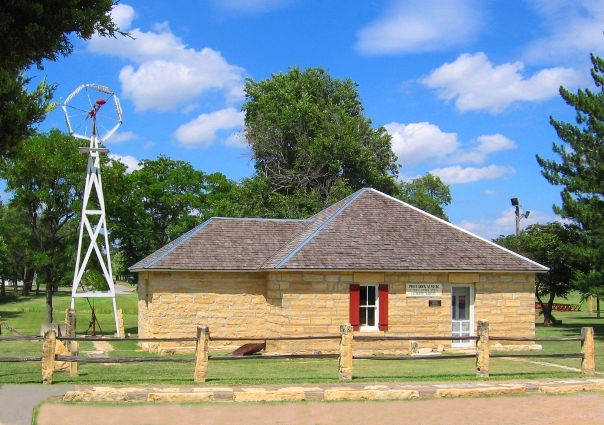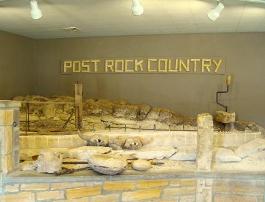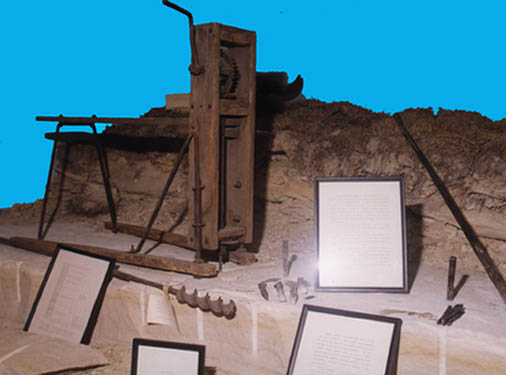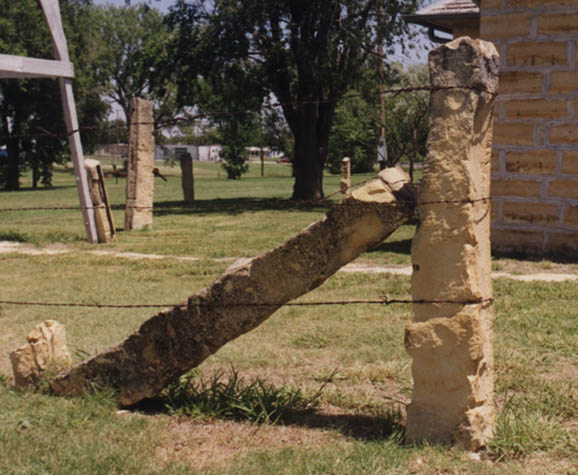The Post Rock Museum
“…I dedicate this building, its story, and its related exhibits to the memory of those intrepid pioneers who years ago accepted the challenge to conquer these western plains and on them build lasting homes for their children, and their childrens children.” - 1964 Myrl V. Walker, Fort Hays Kansas State College (Fort Hays State University)

The museum is housed in a native stone house built by homesteader Dan Haley with the equipment, pioneer ingenuity, and stone it now preserves. Built southwest of Nekoma in 1883, the house was moved in 1963 to its current location to preserve the ingenuity and perseverance of the Kansas pioneers. The museum includes an authentic stone quarry re-creation illustrating the methods used to cut posts for fencing as well as tools and items depicting the history of the post rock unique to this region. Learn more about the history of the museum.
Early pioneers were faced with an unusual difficulty on the expansive plains of Kansas; lack of trees. Most pioneers traveled from the coast where trees were readily available for building, shade, food, and firewood. Kansas, though, was a vast dry prairie where few trees were able to grow due to the drought-like conditions and high occurrences of prairie fires. Early pioneers quickly found a substitution for firewood, a source of fuel very abundant on the open prairies, bison chips. The large round piles of bison dung were literally everywhere on the prairie and burned hot, making it preferable to wood for cooking. However, the pioneers probably did not consider making their homes out of this abundant resource! Instead, the first pioneers made their homes from something even more abundant, the ground itself. Most pioneers could not afford to ship lumber from the coast to build houses, so they made houses in the ground. Some pioneers settled on land that had hills into which they dug their houses, these structures are called dugouts. Pioneers not so fortunate as to have hills on their land, dug down, making dugouts below the ground surface. Other pioneers cut squares from the soil making sod (soil) bricks to build houses. Dugouts and sod houses protected the early pioneers from most dangers, but torrential rainfalls would flood dugouts and common prairie fires could destroy sod houses. These early pioneers of Kansas, like all pioneers, continued to search for a better way to live. These industrious pioneers discovered a layer of rock, located only a few feet below the soil surface, that could be used to make permanent, weather resistant, beautiful buildings. This rock layer is known as limestone and due to the geological formation is just the right thickness (8 to 12 inches) for building stones and posts. When limestone is first exposed it is soft and chalky, making it easier to drill and dress (form). However, once the stone has been exposed to air, the edges become hard making it an exceptional building material for the plains pioneer.
At first, limestone blocks were just used to form the walls of dugouts. As the pioneers recognized the structural potential of limestone, more permanent all-stone buildings were constructed. Limestone blocks quickly became a common building material throughout north-central Kansas. Stone blocks were used to build schools, churches, homes, bridges, posts, decorative stone, window trims, steps, hitching posts, troughs (feed and water), tombstones, and walkways.
Post Rock and Fences
Early limestone quarrying was done at the edges of ravines or outcroppings where the limestone layer was exposed by erosion of the surrounding soil. At first, pioneers sledged out building rocks and dressed (formed and sized) each block with stone hammers. Sledging describes the use of hand drills and hammers to make a straight line of holes along the exposed layer. Once the holes were drilled pinch bars were used to pry the blocks loose. Smaller drills and hammers were then used to size and shape each block for building.

Left: The museum houses a part of an actual quarry moved from southwest of Rush Center, Kansas that illustrates tools and techniques used to quarry posts for fences and buildings.
Pioneer innovation quickly changed the method of quarrying with the invention of specialized tools. Now blocks and posts were quarried using hand-operated drills to place holes into the limestone strata 8 inches apart. Then feathers and wedges were placed in each hole and pounded until the rock split into desired lengths. Some historical sources report that stone blocks could be quarried in the winter by filling the drill holes with water, as the water froze it would expand and split the rock. Tests have been conducted with this method, and have been inconclusive.
In the early 1900's, “Nelse” Sankey, a local blacksmith, invented a machine that used a Maytag engine. This machine operated like a sewing machine, when the drill operator stepped on a low handle, the engine would power the drill.

The large tool shown at right is a stone hand drill called a drilling buck. Men would sit on the bench and crank the handle, twisting the bit into the limestone layer. Laying directly below the hand drill is a bit that was used with the drill. To the right of the drill are feathers and wedges used to split the stone.
Another problem that the homesteader on the treeless prairie faced by the early 1860s was a need to protect crops from cattle and wildlife. During this time the cattle industry was booming and existing range laws protected the cattle owner, requiring farmers to protect their own crops. Early farmers found that the Osage Orange tree grew quickly in the dry Kansas soil and would form a thick hedge impeding cattle and other wildlife that liked to feed on growing crops. Osage Orange, while not as expensive as wooden fence posts, was a costly fence to maintain. So the ever-ingenious pioneer found yet another use for the local limestone layer . . . fence posts.

Depicted at left is a limestone corner post with barbed wire. This post stands at the side of the museum yard and illustrates the typical method of reinforcing corner posts as well as how barbed wire was attached to the posts.
Initially, farmers used the limestone fence posts, now called post rocks, to support smooth wire. Smooth wire was not effective in controlling livestock or wildlife so the use of any fence post was not in high demand. However with the development of barbed wire (a low-cost, highly effective wire), the need for sturdy, low cost, accessible fence posts made the post rocks a valuable asset to the region's farmers. Typically stone posts were quarried where the limestone layer was close to 8 inches thick and each post would be split 6 feet long and 8 inches wide. Each post weighed between 250 to 450 pounds and a team of horses could only haul, at most, 8 posts at a time. Most farmers chose to quarry and haul their own posts, however, many could afford the 25 cents charged per post (delivery included). Post rocks were quarried the same as building blocks, but the increased size and weight made moving them more difficult. The typical method for hauling the posts was to quarry and dress the posts, drive a wagon directly over each post, and attach the post in a sling on the underside of the wagon. The farmer would then drive along the fence line and drop down posts at each posthole, usually set at 10 steps apart. When the posts were released from the underside of the wagon, one end would slide into the hole as the post was lifted upright. An average of 25 posts could be completed each day and typically only the number that were going to be placed were drilled each day to in order to preserve the softness of the posts for dressing. Most post rocks were dressed with 3 or 4 shallow troughs (nicks) to hold wire strands in place but a few farmers drilled holes to thread wire through the post. Eventually, farmers learned to appreciate these post rocks that had a lasting quality of 60 or more years as opposed to the 6 to 10 years of a wooden post.
Post rock fences were used over 40 thousand miles of country, predominately situated in a region from Ford County in southwest Kansas 200 miles northeast to Washington County. The widespread use of post rock fencing and stone post houses created a landscape and culture embued with the spirit of ingenious pioneers. Each post is unique, no two fence posts are the same size, shape, or color, and many even have fossils. Even today, many of the buildings and fences quarried by hand and hauled by horses, are still in use. Why did people stop using post rocks?
Come visit the museum to learn more!
The Post Rock Museum, 202 West 1st Street, La Crosse, Kansas 67548
Voted one of the 8 Wonders of Kansas Customs